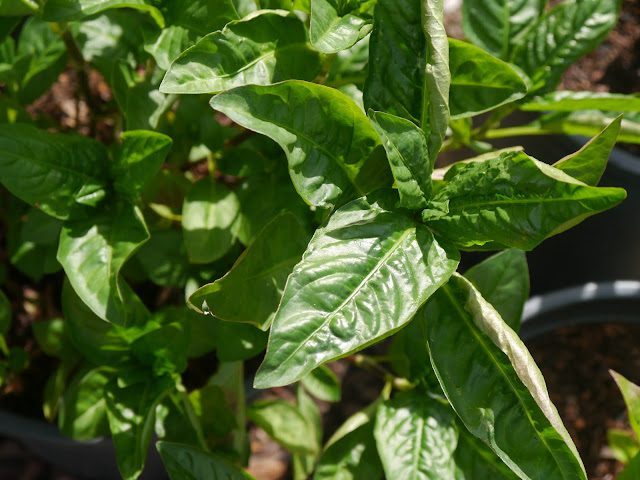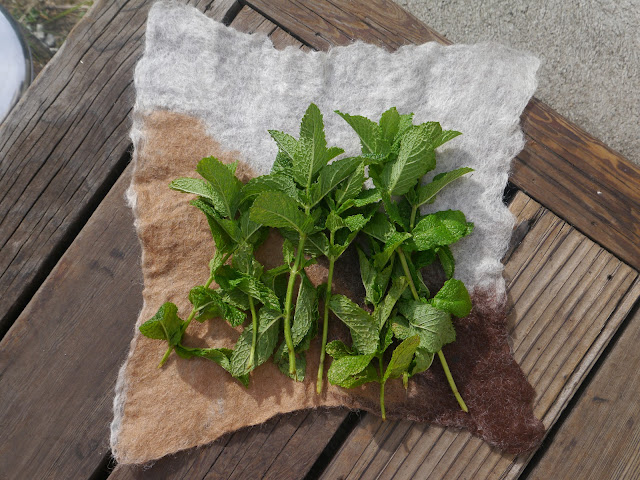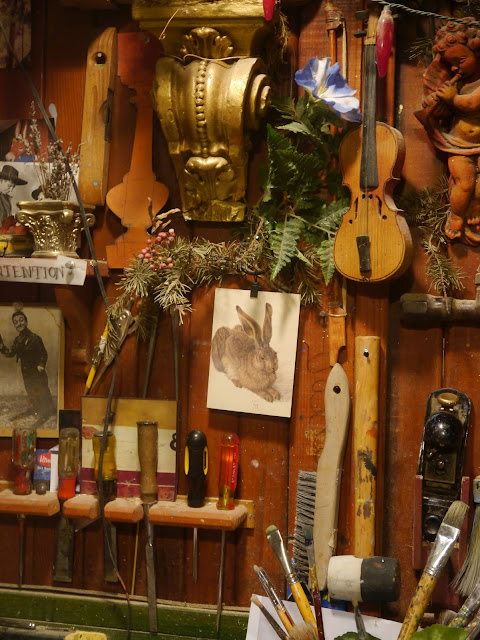Yesterday evening I took BART under the bay (this always makes me marvel, to be tunneled under all that silt and water, where saber-toothed cats and mammoths once walked before the sea filled it in, only about 15,000 years ago) to Simon's mother's store, Kingdom of Herbs, in the San Francisco Ferry building, where we arranged my felt pieces, to be sold! And this morning, on the dawn of the summer solstice, I found the first ripe thimbleberries (that I've seen) of the summer-- perfect, bright red, delicious as sunsets. An auspicious start.
Here are photos from the shop. I plan next to make a series of animals instead of vegetables: fox, owl, whale, deer. I love the slow process of shaping a body with embroidery thread. You have to meditate on the forms and curves of an animal or vegetable to honor the spirit of the thing properly. It feels like a sort of small tribute. The process of felting itself involves a different kind of focus-- you have to let go of the shape YOU want the felt to make, and see what emerges, because each time, the way it interlocks and forms is different. Each piece of felt, when made by hand with soapy hot water and lots of hand-friction, is its own creature, with unpredictable edges.
Eggplant
Sweet pea
Carrot
Artichoke
Landscape, pelt, whatever you like to see in it. I like that it resembles an animal skin. The vegetables are meant to be wall hangings, particularly in a kitchen. This one, however, could be any number of things-- for the wall, a large coaster to put under vases or bowls, a placemat (though you can't wash it in hot water or it will shrink).
I am going to create a separate page on the top right corner devoted to Thimbleberry Feltworks, with a little more information and a basic overview of how felt is made.
Thursday, June 21, 2012
Wednesday, June 20, 2012
Oral Story-telling: A Piece of My Puppet Show
The following is the first ten minutes, read aloud, of the puppet show re-telling of the Norwegian folktale, "East of the Sun, West of the Moon," that I'm working on with Steve Coleman. It's set in the foothills of the Sierras, and on the Farallon Islands, after the Gold Rush, and functions as a series of monologues from different characters telling their versions of the story. I had to make it into a video in order to upload it with the most ease here. The photos are my own, of Tuolomne Meadows, a landscape similar to the one where much of the story takes place, and the Farallon Islands (taken by my boyfriend while on a whale-watching boat that rocked and lunged like a scrap of paper on the Pacific—I was quite unsteady and could not have wielded a camera). Apologies for the poor recording quality. This is just to give a sense of the story, of its strangeness and magic. Imagine human sized puppets with animal heads. Imagine something wholly whimsical, but also dark, and spare, and haunted. Imagine a world on stage where everything—the rocks and rivers, the winds and bears and golddust— is alive. And, of course, imagine music, the twang of stringed instruments, the ghostly trills of whistle and harmonica.
Monday, June 18, 2012
Grown-up Indigo and a Visit to the Workshop
The Indigo plants I've been rearing are getting so big and robust, their leaves glossy and turning dark, I can barely contain my excitement. When they start to develop a blue tinge at their edges, and burst out purple blossoms, it will be time to harvest, maybe in mid-July. I'm embarrassed to admit I've never grown anything from seed, tending it start to finish, like this, and it is magic embodied. To see a seed the size of a bird-pupil turn into these—it reminds you that we humans know so little, about anything, about the processes of life that we are part of. It is a kind of worship, to tend a plant, to help it flourish. And though I've surely helped these Indigos grow strong and fast, in truth, they've given me much more than I could ever give them. When I embark on the process of fermenting the leaves into dye, I may become a total convert to the art and magic of Indigo-- seed to vat to wool, turning the color of the sky.
We had a hot, dry weekend, and the Indigos reached up their dark green leaves with joy. That's the sort of weather they love. It was a lazy day, the sun fell in through the door and warmed up our small fox-den of a home. Simon found a patch of spearmint up the road, and I gathered an armload to make Moroccan mint tea, which, so they say, actually cools your body down on a hot day, particularly a desert-dry one. It was the perfect thing.
I've been working on more felt pieces, like the one here, to start a little business called "Thimbleberry Feltworks," I think. I'll post a new page here when I've finished my first set of products.
The following are images from the writing desk and wool-trunk.
This is my Victorian writing box, found by my wonderful Aunt Lisa somewhere mysterious. It is tilted upright slightly, for ease of writing and to minimize neck-hunching. I use it every morning, as the birds sing and the sun gets higher, with a cup of tea. It closes up and locks, and holds papers, stamps, ink containers, ribbons, inside.
Other bits from the desk, my little workshop. The beautiful watercolors were made by my friend Lara.
Teasel, terra-cotta pot I fired in a model-Etruscan kiln (what a bright bonfire of a blaze, all through the midsummer night!) with a bit of glaze made from materials found on the paths near Spannocchia last summer.
Old postcards, handkerchief, two Madonnas.
This is the home of my wools and yarns, an old Civil War steamer trunk.
She looks like the Lady of the Lake. I wonder who pasted her there, who she is.
The wools are wrapped up in bags, to keep the moths out.
We had a hot, dry weekend, and the Indigos reached up their dark green leaves with joy. That's the sort of weather they love. It was a lazy day, the sun fell in through the door and warmed up our small fox-den of a home. Simon found a patch of spearmint up the road, and I gathered an armload to make Moroccan mint tea, which, so they say, actually cools your body down on a hot day, particularly a desert-dry one. It was the perfect thing.
I've been working on more felt pieces, like the one here, to start a little business called "Thimbleberry Feltworks," I think. I'll post a new page here when I've finished my first set of products.
The following are images from the writing desk and wool-trunk.
This is my Victorian writing box, found by my wonderful Aunt Lisa somewhere mysterious. It is tilted upright slightly, for ease of writing and to minimize neck-hunching. I use it every morning, as the birds sing and the sun gets higher, with a cup of tea. It closes up and locks, and holds papers, stamps, ink containers, ribbons, inside.
Other bits from the desk, my little workshop. The beautiful watercolors were made by my friend Lara.
Teasel, terra-cotta pot I fired in a model-Etruscan kiln (what a bright bonfire of a blaze, all through the midsummer night!) with a bit of glaze made from materials found on the paths near Spannocchia last summer.
Old postcards, handkerchief, two Madonnas.
This is the home of my wools and yarns, an old Civil War steamer trunk.
She looks like the Lady of the Lake. I wonder who pasted her there, who she is.
The wools are wrapped up in bags, to keep the moths out.
Friday, June 15, 2012
The Magic of Teasel
The bodies of those spiked plants I
crooned over in my last post speak a strong language. They reached out and sang
their strange, spindle-pricking song to me, and as it turns out, they are very
potent indeed. It was not just my imagination.
My wonderful cousin Lyda informed
me that this is teasel, or dipsacus
fullonum. Its native homelands are the continents of Europe, Asia and
Northern Africa. It is considered an invasive weed in North America. (A
difficult concept for me—aren’t the majority of us here “invasive”?) It turns
out that the word “to tease,” as in “to tease out a knot” is the root for the
name “teasel” because the dried heads were used for centuries as carding combs,
before metal spines were created in factories. If you run your fingers over
one, dried a dark gold, you will understand why—they are taut and strong, so robust
they make a plucked melody under your fingertips. Cobwebs get caught around
them. I could untangle knots in my hair with a single empty seedhead without
breaking it.
The Latin name fullonum is related to the word “to full” which means “to card wool
before spinning.” A fuller is a person who cards wool. The first part of the Latin
name, dipsacus, means “to thirst” in
Greek, and refers to the way the leaves gather water in their green bowl around
the stem. Ancient Roman’s called teasel “Venus’s Basin,” and Christian’s “Mary’s
Basin.” Perhaps they collected the water for their own joints. Teasel eases
arthritis.
Plant biologists, on the other
hand, speculate that these dew-receptacles prevent insects such as aphids from
climbing anywhere near the flowers. They’ve filled up the bowls with dead bugs
to test the results, and have found that the more rotting insects in that basin
of Venus, the more seeds the teasel head produces. In other words, teasel
absorbs the nutrients of dead bugs through its stem-bowls. It is partially
carnivorous. That water is holy for the plant as well people—it is its own composting
system.
Romany gypsies gathered rainwater
from those teasel-bowls and used it for wrinkles and dark circles under the
eyes. A common name for the plant is “gypsy-comb.”
Japanese Teasel has been used in
Chinese medicine for thousands of years. They call the plant Xu Duan, which
means, “restore what is broken.” Japanese teasel root is used for arthritis,
blood circulation, kidney cleansing and the healing of damaged tissues. In
North America, herbalists such as Matthew Wood have discovered that common
teasel can be used to treat lyme disease. A few drops of teasel-tincture can
sniff out lyme disease bacterial cells where they hide, burrowed in joints. It
chases them right into your blood, out of hiding, where other forms of
medication can then destroy them.
Other medicinal uses I’ve
discovered include: wort-cure, antibiotic, and eyewash.
There are powers deeper than words
and deeper than songs that rest in the bodies of the plants all around us.
Their characters are written in their shapes and colors, their curves and
spines and flowers. This too is its own language, separate from the language of
deer mouse tracks, vole tunnels, bobcat scratches, and thrush songs. Teasel is dressed
in elegant, wily green armor. She guards her own.
Now I see why the deer take big,
eager bites from the teasel leaves. They know their own midwifery better than
any of us. I’d bet it was the does, cleansing their blood, soothing their
joints, after the weight of fawn-birth.
None of this is to say that, at
night, strange forms do not rise up from those basins, those carding-comb pods.
Slight, tendriled figures that walk barefoot, dispense water from green
leaf-bowls to mother creatures as they give birth—raccoons, squirrels, deer, snakes.
Comb the burrs from their tails. Take the stray fur-pieces home and spin them
into ropes for climbing down, down into the underworld, where necessary
knowledge about rebirth, about chasing pain out of tight spaces, lives, pushed
into deep quartz veins by the songs of moles. Where knowledge about smoothing
out tangles and keeping the heart clear resides.
 |
| Illustration by Arthur Rackham |
This week,
I’ve also been at work on a felting project. I love the feeling of rolling and
shaping felt, soapy warm hands and sore arms, the smell of wet wool. Because it’s
wet and a bit messy, it really demands to be made outside, on the deck, by
the rosemary. The sun on my back. Listening to young blue jays screech, the towhees
cheep. Having a ginger ale or a beer. Each piece of felt is a surprise, still alive in its form. You never
know what it will be until it’s done, the edges rippled like an animal hide. The act of felting is meditative. It warms up the body and quiets the mind.
I’m
embroidering these with vegetables: first a sweet pea. I’m working on an
artichoke and a carrot now. For hanging in the kitchen, or wherever you like.
Honoring the forms and bounty of vegetables. I plan to make a variety of creatures too—fox, elk, owl, heron. More (and better) photos coming soon.
I think I'll try combing a bit of uncarded wool I have with a teasel head, too.
Friday, June 8, 2012
The Mysterious Thorned Deer-Tonic
They have the look of scepters, they guard their rich green
leaves well with spikes and thorns, as if keeping something very special safe.
Maybe there is a tonic in those robust stems. Maybe an elixir in the head,
furred with elegant spear-tips. It will turn a soft purple in the late summer,
gentler than the color of thistles. I remember this from walking the Wildcat
Canyon trail last July. They hold that seed-head, that pollen-orb, with
spindles of green, a star. The top looks like the crown on the head of a chaparral queen, her
wings the orange-black-silver of a varied thrush singing into the dusk, her
body painted in creek-silt, her face a gray-fox’s, eyes tapered and dark.
I’m enchanted by these robust, spiked plants. My friend
Cynthia and I, wandering the Wildcat Canyon trail in search of animal tracks
yesterday evening, came across a thick crop of them in a field of hemlock that
glowed as the late sun began to head down toward the ocean. We found them off
the side of a deer trail through dry grass. We noticed the deer had munched the
big leaves. They left nearby thistles and other greenery alone. They went for
these leaves, despite the small white thorns. Cynthia said: plants with thorns often guard
something powerful in them. Nettles, milk thistle, hawthorn, they are healing.
Are the mother deer eating them to regain strength after
giving birth in these last few months? Are they nudging their speckled fawns
toward the thick leaves to make them grow healthy and big?
What is this green star-crown of a plant? Is it related to a
thistle? Is it in fact being harvested at night by shape-shifting beings with
thrush wings, fox faces, human hands, who weave the stalk-fibers into nets for
climbing the stars and boil the leaves for stomach aches? This plant has a
magic about it, and I’m spiraling into myth to give it a name.
If anyone knows, do comment below.
Sunday, June 3, 2012
Clay Puppets, Thistles and the Fertile Chaos of An Artist's Studio
I went to visit Steve Coleman on Saturday to talk about our puppet show. This is his studio, at night, above a theater. It is pure magic, full of rich colors and the strange faces of puppets, clocks, painted cupolas and Venetian balconies, mice in vests reading in pagodas, stray teacups, saws, brushes, nasturtiums or peonies in vases, a metal saucepan with chai tea bags sticking out, books and books on renaissance art, fairytales, romantic poetry, records. At the moment, this puppet show is deep in the rich mud of both of our minds, about to spring forth from all the beauty of just-managed chaos. I wish the studio in my mind looked exactly like this:
This is the flavor of the story we are creating-- me in words, Steve in puppets and sets. Who knows what it will look like in the end? Something that takes you beyond the veil of the seen and known, into the strange and dark, the whimsical and the earthen, a world where grizzly bears, trolls and riverbeds speak, yearn and suffer, a world where the winds walk like men with harmonicas and the forgotten deities, spirits, imps, of immigrants live in the places between: cracks in stone, blustery islands, patches of dandelion and thistle.
Below are two pages of the puppet show from my notebook, just a little taste. Everything starts on paper, with a good, trusted, smooth pen, much of the time on the Victorian writing box my Aunt gave me for my birthday a few years ago, tilted up just enough so you don't have to hunch over your words, with space inside for paper, nibs, ribbons, envelopes, whatever you want to hide in it.
Subscribe to:
Posts (Atom)

















































